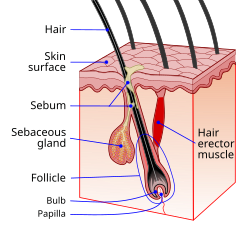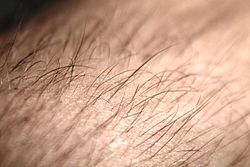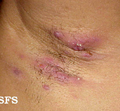Can Animal Hairs Attached To Human Follicles
| Hair follicle | |
|---|---|
 Hair follicle | |
 A photograph of pilus on a homo arm emerging from follicles | |
| Details | |
| Arrangement | Integumentary system |
| Artery | Supratrochlear, supraorbital, superficial temporal, occipital |
| Vein | Superficial temporal, posterior auricular, occipital |
| Nerve | Supratrochlear, supraorbital, greater occipital, lesser occipital |
| Lymph | Occipital, mastoid |
| Identifiers | |
| Latin | Folliculus pili |
| MeSH | D018859 |
| TA98 | A16.0.00.023 |
| TA2 | 7064 |
| TH | H3.12.00.iii.01034 |
| FMA | 70660 |
| Anatomical terminology [edit on Wikidata] | |
The hair follicle is an organ found in mammalian pare.[1] It resides in the dermal layer of the skin and is made upward of 20 different cell types, each with distinct functions. The hair follicle regulates hair growth via a complex interaction between hormones, neuropeptides, and immune cells.[i] This circuitous interaction induces the pilus follicle to produce different types of pilus every bit seen on different parts of the body. For example, terminal hairs grow on the scalp and lanugo hairs are seen covering the bodies of fetuses in the uterus and in some newborn babies.[1] The process of pilus growth occurs in distinct sequential stages. The starting time stage is called anagen and is the active growth phase, telogen is the resting stage, catagen is the regression of the hair follicle phase, exogen is the active shedding of hair phase and lastly kenogen is the phase between the empty pilus follicle and the growth of new hair.[1]
The office of pilus in humans has long been a discipline of interest and continues to be an important topic in society, developmental biology and medicine. Of all mammals, humans accept the longest growth phase of scalp pilus compared to pilus growth on other parts of the body.[1] For centuries, humans accept ascribed esthetics to scalp hair styling and dressing and it is often used to communicate social or cultural norms in societies. In addition to its office in defining human advent, scalp pilus as well provides protection from UV sun rays and is an insulator against extremes of hot and cold temperatures.[1] Differences in the shape of the scalp hair follicle determine the observed indigenous differences in scalp hair appearance, length and texture.
In that location are many homo diseases in which abnormalities in pilus appearance, texture or growth are early signs of local illness of the hair follicle or systemic disease. Well known diseases of the hair follicle include baldness or hair loss, hirsutism or excess hair growth and lupus erythematosus.[ii]
Structure [edit]

Construction of a hair follicle.
The position and distribution of hair follicles changes over the torso. For example, the skin of the palms and soles does not have hair follicles whereas skin of the scalp, forearms, legs and genitalia has arable hair follicles.[1] There are many structures that make up the hair follicle. Anatomically, the triad of hair follicle, sebaceous gland and arrector pili musculus brand upwards the pilosebaceous unit.[one]
A hair follicle consists of :
- The papilla is a large structure at the base of the hair follicle.[three] The papilla is made upwardly mainly of connective tissue and a capillary loop. Cell division in the papilla is either rare or non-existent.[ contradictory ]
- Around the papilla is the hair matrix.
- A root sheath composed of an external and internal root sheath. The external root sheath appears empty with cuboid cells when stained with H&E stain. The internal root sheath is composed of three layers, Henle'south layer, Huxley's layer, and an internal cuticle that is continuous with the outermost layer of the hair fiber.
- The bulge is located in the outer root sheath at the insertion point of the arrector pili muscle. It houses several types of stem cells, which supply the entire hair follicle with new cells, and take part in healing the epidermis after a wound.[iv] [5] Stalk cells express the marker LGR5+ in vivo.[half dozen]
Other structures associated with the hair follicle include the cup in which the follicle grows known as the infundibulum,[seven] the arrector pili muscles, the sebaceous glands, and the apocrine sweat glands. Pilus follicle receptors sense the position of the hair.
Attached to the follicle is a tiny packet of muscle cobweb chosen the arrector pili. This muscle is responsible for causing the follicle lissis to get more perpendicular to the surface of the pare, and causing the follicle to protrude slightly above the surrounding peel (piloerection) and a pore encased with skin oil. This process results in goose bumps (or goose mankind).
Also attached to the follicle is a sebaceous gland, which produces the oily or waxy substance sebum. The higher the density of the hair, the more sebaceous glands that are found.
Variation [edit]
There are indigenous differences in several dissimilar hair characteristics. The differences in advent and texture of hair are due to many factors: the position of the hair seedling relative to the hair follicle, size and shape of the dermal papilla, and the curvature of the hair follicle.[i] The scalp pilus follicle in Caucasians is elliptical in shape and, therefore, produces directly or wavy hair, whereas the scalp hair follicle of people of African descent is more curvy, resulting in the growth of tightly curled hair.[1]
| ethnicity | bore (micrometers) | cross-sectional shape | appearance |
|---|---|---|---|
| Blonde-haired Caucasian | xl–80 | elliptical | straight or wavy |
| Night brown/black haired/ruby haired Caucasian | 50–90 | elliptical | straight or wavy |
| Blackness | 60–100 | elliptical and ribbon-similar | curly |
| Asian | 80–100 | circular | directly |
| Animal | diameter (micrometers) | cross-sectional shape | appearance |
|---|---|---|---|
| Chimpanzee | 101-113 | circular | straight |
| Orangutan | 140-170 | round | straight |
| Buffalo | 110 | circular | straight |
Evolution [edit]
In utero, the epithelium and underlying mesenchyme interact to form hair follicles.[10] [11]
Aging [edit]
A key aspect of pilus loss with age is the crumbling of the hair follicle. Ordinarily, hair follicle renewal is maintained past the stem cells associated with each follicle. Crumbling of the pilus follicle appears to be primed by a sustained cellular response to the Dna damage that accumulates in renewing stem cells during aging.[12] This damage response involves the proteolysis of type XVII collagen by neutrophil elastase in response to the Dna damage in the hair follicle stem cells. Proteolysis of collagen leads to elimination of the damaged cells and so to final hair follicle miniaturization.
Hair growth [edit]
Hair grows in cycles of diverse phases:[13] anagen is the growth stage; catagen is the involuting or regressing phase; and telogen, the resting or quiescent phase (names derived using the Greek prefixes ana-, kata-, and telos- meaning up, down, and cease respectively). Each phase has several morphologically and histologically distinguishable sub-phases. Prior to the start of cycling is a phase of follicular morphogenesis (formation of the follicle). At that place is also a shedding phase, or exogen, that is independent of anagen and telogen in which one or several hairs that might arise from a single follicle exits. Unremarkably up to 90% of the hair follicles are in anagen phase, while 10–14% are in telogen and 1–2% in catagen. The bicycle'due south length varies on unlike parts of the trunk. For eyebrows, the bicycle is completed in around iv months, while information technology takes the scalp 3–four years to finish; this is the reason eyebrow pilus have a much shorter length limit compared to hair on the head. Growth cycles are controlled past a chemical signal like epidermal growth factor. DLX3 is a crucial regulator of hair follicle differentiation and cycling.[14] [15]
Anagen phase [edit]
Anagen is the active growth phase of pilus follicles[sixteen] during which the root of the hair is dividing rapidly, adding to the hair shaft. During this phase the pilus grows nearly i cm every 28 days. Scalp hair stays in this active phase of growth for two–7 years; this period is genetically adamant. At the finish of the anagen phase an unknown indicate causes the follicle to go into the catagen phase.
Catagen phase [edit]
The catagen phase is a brusque transition stage that occurs at the end of the anagen phase.[17] Information technology signals the finish of the active growth of a pilus. This phase lasts for about two–three weeks while the pilus converts to a club pilus. A club hair is formed during the catagen stage when the office of the hair follicle in contact with the lower portion of the hair becomes attached to the hair shaft. This process cuts the hair off from its blood supply and from the cells that produce new hair. When a club hair is completely formed, about a 2-week process, the pilus follicle enters the telogen phase.
Telogen phase [edit]
The telogen phase is the resting phase of the hair follicle.[18] When the body is subjected to extreme stress, every bit much as 70 percent of hair can prematurely enter the telogen stage and begin to fall, causing a noticeable loss of hair. This condition is called telogen fetor.[19] The guild hair is the final product of a hair follicle in the telogen stage, and is a expressionless, fully keratinized hair.[ten] Fifty to one-hundred club hairs are shed daily from a normal scalp.[10]
Timeline [edit]
- Scalp: The time these phases concluding varies from person to person. Different hair color and follicle shape affects the timings of these phases.
- Anagen stage, 2–8 years (occasionally much longer)
- Catagen phase, 2–three weeks
- Telogen phase, around three months
- Eyebrows:
- Anagen phase, four–vii months
- Catagen phase, 3–4 weeks
- Telogen phase, almost 9 months
Clinical significance [edit]
Disease [edit]
| | This section needs expansion. You can help by adding to it. (January 2018) |
There are many human diseases in which abnormalities in hair appearance, texture or growth are early on signs of local disease of the pilus follicle or systemic disease. Well known diseases of the hair follicle include alopecia or pilus loss, hirsutism or backlog pilus growth, and lupus erythematosus.[two] Therefore, understanding the part of the normal hair follicle is fundamental to diagnosing and treating many dermatologic and systemic diseases with hair abnormalities.[two]
-

-

Alopecia scale
-

-

Hair restoration [edit]
Hair follicles class the basis of the two primary methods of hair transplantation in hair restoration, Follicular Unit Transplantation (FUT) and follicular unit extraction (FUE). In each of these methods, naturally occurring groupings of one to iv hairs, called follicular units, are extracted from the hair restoration patient and then surgically implanted in the balding area of the patient'due south scalp, known as the recipient area. These follicles are extracted from donor areas of the scalp, or other parts of the trunk, which are typically resistant to the miniaturization effects of the hormone DHT. It is this miniaturization of the hair shaft that is the main predictive indicator of androgenetic alopecia,[20] normally referred to as male design alopecia or male pilus loss. When these DHT-resistant follicles are transplanted to the recipient expanse, they proceed to grow hair in the normal pilus bike, thus providing the hair restoration patient with permanent, naturally-growing hair. More than than 60% of men and 10% of women endure from hair loss.[21] [ better source needed ]
While hair transplantation dates back to the 1950s,[22] and plucked human hair follicle prison cell civilization in vitro to the early 1980s,[23] it was not until 1995 when pilus transplantation using individual follicular units was introduced into medical literature.[24]
References [edit]
- ^ a b c d e f yard h i j k Blume-Peytavi, Ulrike (2008). Hair growth and disorders. Berlin: Springer. ISBN9783540469117. OCLC 272298782.
- ^ a b c Gilhar, Amos; Etzioni, Amos; Paus, Ralf (2012-04-19). "Alopecia areata". The New England Journal of Medicine. 366 (xvi): 1515–1525. doi:10.1056/NEJMra1103442. ISSN 1533-4406. PMID 22512484. S2CID 5201399.
- ^ Pawlina, Wojciech; Ross, Michael W.; Kaye, Gordon I. (2003). Histology: a text and atlas: with prison cell and molecular biology. Hagerstown, Maryland: Lippincott Williams & Wilkins. ISBN978-0-683-30242-4.
- ^ Ma DR; Yang EN; Lee ST (2004). "A review: the location, molecular characterisation and multipotency of hair follicle epidermal stem cells". Ann. Acad. Med. Singap. 33 (half-dozen): 784–8. PMID 15608839.
- ^ Cotsarelis 1000 (2006). "Epithelial stalk cells: a folliculocentric view". J. Invest. Dermatol. 126 (vii): 1459–68. doi:10.1038/sj.jid.5700376. PMID 16778814.
- ^ Lin, K. K.; Andersen, B. (2008). "Have Hair Follicle Stem Cells Shed Their Tranquil Epitome?". Cell Stem Cell. iii (six): 581–582. doi:10.1016/j.stem.2008.eleven.005. PMID 19041772.
- ^ "Histologic Diagnosis of Inflammatory Skin Diseases, Chapter 1. Embryologic, Histologic, and Anatomic Aspects". Derm101.com. Archived from the original on 2012-ten-21.
- ^ Chernova, Olga (May 2014). "Scanning electron microscopy of the hair medulla of orangutan, chimpanzee, and man". Journal of Biological Sciences. 456 (1): 199–202. doi:10.1134/S0012496614030065. PMID 24985515. S2CID 6597226.
- ^ S.V, Kshirsagar (July 2009). "Comparative Study of Human and Animal Hair in Relation with Diameter and Medullary Index" (PDF). Indian Journal of Forensic Medicine and Pathology. 2 (3). Archived from the original (PDF) on 2021-12-22. Retrieved 2022-02-21 .
- ^ a b c Paus R; Cotsarelis G (August 1999). "The biology of hair follicles". North. Engl. J. Med. 341 (7): 491–7. doi:10.1056/NEJM199908123410706. PMID 10441606.
- ^ "Hair Follicle". 2017-eleven-27. Archived from the original on 2018-12-16. Retrieved 2018-12-18 . Wed, xix Dec 2018
- ^ Matsumura H, Mohri Y, Binh NT, Morinaga H, Fukuda M, Ito Thousand, Kurata South, Hoeijmakers J, Nishimura EK (2016). "Hair follicle crumbling is driven by transepidermal elimination of stem cells via COL17A1 proteolysis". Science. 351 (6273): aad4395. doi:10.1126/science.aad4395. PMID 26912707. S2CID 5078019.
- ^ 1000. Due south. Stenn & R. Paus (ane January 2001). "Controls of Hair Follicle Cycling". Physiological Reviews. 81 (one): 449–494. doi:10.1152/physrev.2001.81.1.449. PMID 11152763. S2CID 35922975. (comprehensive topic review, successor to landmark review of 1954 by HB Chase)
- ^ Hwang, J.; Mehrani, T.; Millar, Southward. E.; Morasso, K. I. (2008). "Dlx3 is a crucial regulator of hair follicle differentiation and cycling". Development. 135 (eighteen): 3149–3159. doi:10.1242/dev.022202. PMC2707782. PMID 18684741.
- ^ Park, Thousand. T.; Morasso, K. I. (2002). "Bone morphogenetic poly peptide-2 (BMP-2) transactivates Dlx3 through Smad1 and Smad4: Alternative manner for Dlx3 induction in mouse keratinocytes". Nucleic Acids Research. 30 (2): 515–522. doi:10.1093/nar/thirty.2.515. PMC99823. PMID 11788714.
- ^ Brannon, Maryland, Heather. "Anagen Phase". The New York Times . Retrieved 2007-11-14 .
- ^ Brannon, Maryland, Heather. "Categen Stage". The New York Times . Retrieved 2007-11-14 .
- ^ Brannon, Maryland, Heather. "Telogen Phase". The New York Times . Retrieved 2007-11-14 .
- ^ S Malkud (i September 2015). "Telogen Fetor: A Review". J Clin Diagn Res. nine (9): WE01–3. doi:10.7860/JCDR/2015/15219.6492. PMC4606321. PMID 26500992.
- ^ Bernstein RM; Rassman WR (September 1997). "Follicular transplantation. Patient evaluation and surgical planning". Dermatol Surg. 23 (ix): 771–84, give-and-take 801–v. doi:10.1111/j.1524-4725.1997.tb00417.x. PMID 9311372. S2CID 32873299.
- ^ "What Is Clarifying Shampoo & Does Your Hair Need It?". Mapleholistics.com. 2017-06-29. Retrieved 2019-06-03 .
- ^ Orentreich N (November 1959). "Autografts in alopecias and other selected dermatological atmospheric condition". Ann. Northward. Y. Acad. Sci. 83 (3): 463–79. doi:10.1111/j.1749-6632.1960.tb40920.x. PMID 14429008. S2CID 35356631.
- ^ Wells J; Sieber VK (Dec 1985). "Morphological characteristics of cells derived from plucked man hair in vitro". Br. J. Dermatol. 113 (6): 669–75. doi:x.1111/j.1365-2133.1985.tb02402.10. PMID 2420350. S2CID 31137232.
- ^ Bernstein RM; Rassman WR; Szaniawski Due west; Halperin A (1995). "Follicular Transplantation". Intl J Aesthetic Restorative Surgery. three: 119–32. ISSN 1069-5249. OCLC 28084113.
External links [edit]
-
 Media related to Hair follicle at Wikimedia Commons
Media related to Hair follicle at Wikimedia Commons
Source: https://en.wikipedia.org/wiki/Hair_follicle
Posted by: elkinsextur1962.blogspot.com

0 Response to "Can Animal Hairs Attached To Human Follicles"
Post a Comment